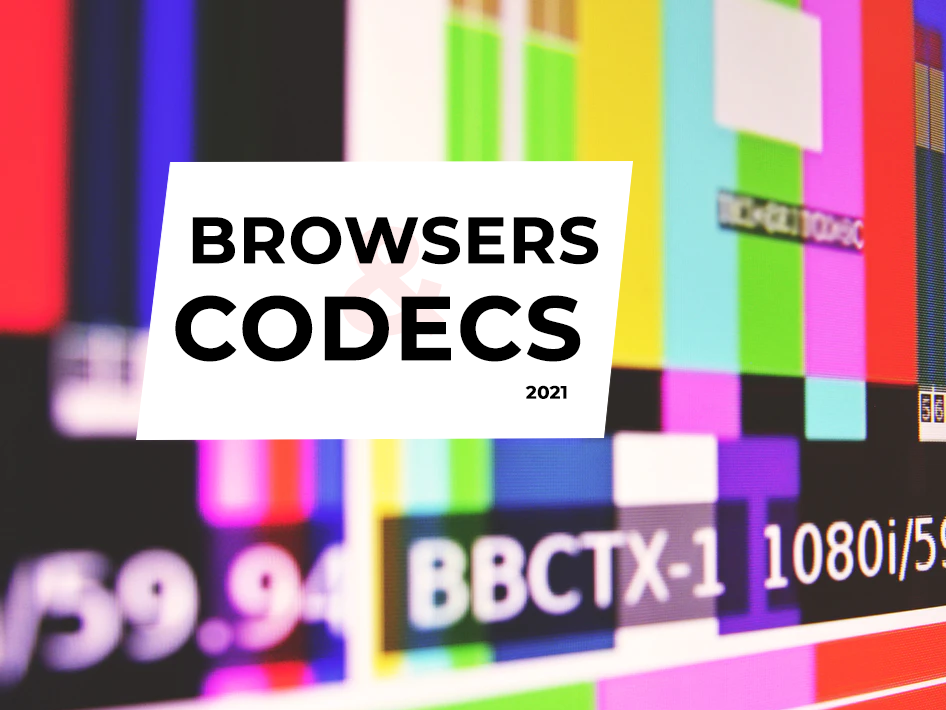Codecs and browsers – an overview for 2021

Video marketing is booming again. It is estimated that the average time of watching videos online in 2021 will exceed 100 minutes a day. In turn, this year video advertising on the Internet is expected to increase by 10% compared to the previous year. More importantly, in the near future we can observe a huge increase in the popularity of in-stream ad campaigns, which engage viewers to a greater extent and more effectively than ever.
And just as video on the web will become a more and more widely used format, the forms of its transmission will also evolve. Check out our overview of video codecs and containers that will be used in 2021!
Codecs versus containers in 2021
The most important aspect of proper online video streaming is the adequate selection of video formats. Formats should be selected on the basis of UX, browser and system support, compression efficiency or encoding speed, and the broadcast itself.
If you know the extension of the video, you can determine what container is supported. However, the file extension itself won’t help you recognize its codec. And you need to know the codec to be able to determine whether the video will be supported by the browser or system.
For example, a vast majority of websites and systems on the web use the MP4 container and the H264 codec to encode videos. But not every movie with MP4 extension will be supported by all browsers or systems, because the file itself may be encoded with a codec other than H264.
The whole situation is also complicated by the implementation of the Adaptive Bit Rate (ABR) technology. It enables users to cache small fragments of video and adjust the quality of the displayed video to the connection speed and user preferences.
Let’s check the most popular codecs in 2021:
H.264 / AVC
H264 / AVC is the main codec of the MP4 container. Sometimes it is used by video files placed in the M4V container. The MP4 video file extension was developed by Apple for H264 encoded content and DRM protected movies.
All browsers and systems support this video format – both iOS and Android. Besides, almost every output device supports hardware acceleration for the H264 codec. That’s why the use of the H264 codec and the MP4 container is extremely easy – especially when the streamed video is being watched on extremely exotic end devices systems or browsers.
H.265 / HEVC
The H265 codec and MP4 container will provide significantly higher compression efficiency (up to 50% lighter) while maintaining a much lower risk of generating image artifacts. Unfortunately, the problem with this codec is that it cannot be used on older Apple devices (requires iOS 11 or MacOS High Sierra).
Unfortunately, even with hardware acceleration, the greater complexity of the H265 format makes it much slower to decode.
VP9
VP9 is an open-source codec that was developed by Google. Instead of MP4, it uses the Webm container – mkv. The VP9 codec provides similar benefits to the H265, but VP9 is only slightly less efficient. Nevertheless, it is still much more efficient than the H264.
The VP9 codec reduces the weight of the video and at the same time lowers the risk of image artifacts. Video encoding is relatively slow – similar to H265.
If you want to use the VP9 codec, remember that it can be used only with devices and systems in the Google ecosystem (Android and Chrome).
VP8
VP8 is the older brother of the VP9 codec, created by On2 Technologies. After the company was purchased by Google, most of the patents associated with this codec were opened, allowing it to be quickly adopted in modern web browsers. The efficiency of the codec can be compared to the H264 with which it has many common features, although it is clearly inferior to it in terms of the generated image quality.
The most popular use of VP8 today is of course WebRTC. This codec does not require as much system resources as VP9, it is also able to take advantage of the hardware acceleration offered by the size of ARM processors.
Its biggest disadvantage is, just like it was the case with its younger brother, that it’s not supported on iOS platforms.
Codecs supported by Storm
Storm Streaming Server offers support for both H.264 and H.265 codecs, ensuring the best possible coverage among modern browsers on both personal computers and mobile devices (both iOS and Android families). The VP9 and VP8 codec along with the WebRTC protocol will also be available in the future updates.